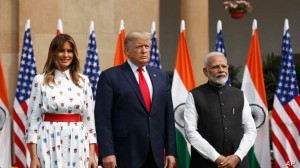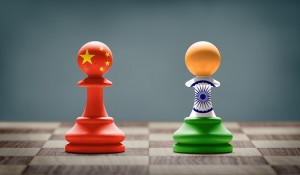The Indo-US Connivance Against China
It is evident from the developments as well as the US engagements with India during the past decade or so that America’s grand strategy towards China is primarily to achieve a ‘balance of power in Asia.’ This is evidenced by the Indo-US strategic partnership that has soared to an unprecedented level during the recent years. According to the realist paradigm, of which balance of power is a part, states tend to enter in alliances to maintain balance of power, especially if they are entangled in contest with more powerful or potentially challenging adversary.
The world can clearly witness an unrelenting struggle of the world’s sole superpower, i.e. the United States, to contain China. In fact, emergence of the dragon on the world stage and the tough competition it has given to the West in all spheres; economic, political, and strategic, appears to have rattled the US policymakers. The US has taken China as its key rival and has been directing considerable energies and efforts to contain China’s rapid surge in order to keep the world order that it leads intact. The Indo-Pacific region is seen as the main battleground in this China-containment policy.
Although the Indo-Pacific region has become a pivotal geopolitical location today, the shift of US’s focus from the Middle East to Asia can be traced back to Obama’s first term as President of the United States.
In this regard, in November 2011, Hillary Clinton, the then-Secretary of State, delivered a policy speech at East-West Center, Honolulu, Hawaii, whereby she maintained that America will continue to play a leader’s role in the region and that the 21st century will be ‘America’s Pacific century.’ She said:
“And just as the United States played a central role in shaping that architecture across the Atlantic—to ensure that it worked, for us and for everyone else—we are now doing the same across the Pacific. The 21st century will be America’s Pacific century, a period of unprecedented outreach and partnership in this dynamic, complex and consequential region. Now this goal is not ours alone. It is one that many across the region hold. I have heard from many different counterparts across the Asia Pacific an urgent desire for American leadership, which has brought benefits to this region already for decades.”
As a rationale for the said policy, Ms Clinton demoed two main “challenges facing the Asia-Pacific … that demand America’s leadership, from ensuring freedom of navigation in the South China Sea to countering North Korea’s provocations and proliferation activities to promoting balanced and inclusive economic growth.” Predicting the shift of power to Asia with the presence of world’s rising economies, Ms Clinton asserted, “It is becoming increasingly clear that, in the 21st century, the world’s strategic and economic centre of gravity will be the Asia-Pacific, from the Indian subcontinent to western shores of the Americas.”
Her remarks clearly indicate that the policy of rebalancing was, in effect, meant to deal with China’s rise as US policymakers have long believed that the territorial disputes in the South China Sea are a strategic opportunity for the US to cast Beijing as a bullying and aggressive rising power and themselves as the indispensable guardians of regional order and international law.
South China Sea is one of the many fronts of America’s China-containment policy. The US wants a greater role for India in the region and beyond, and is investing its unwavering trust and massive resources for that. During the same period, the US and India accelerated their partnership which culminated during president Obama’s 2010 speech in Indian parliament where he expressed, “Firm belief that the relationship between the United States and India—bound by our shared interests and values—will be one of the defining partnerships of the 21st century.” Obama’s 2010 visit was of great significance as the US president unprecedentedly endorsed and ensured support for India’s bid to become a permanent member of the United Nations Security Council (UNSC) for a “just and sustainable international order.” It was being seen by observers, even Americans, as a part of America’s policy to favour India not only to reap commercial gains but also to check the influence of an increasingly assertive China.
More recently, President Trump’s announcement was self-explanatory of his policy on China and evidently he was the first president who was so explicit about US policy of containment. He made it clear that if he were elected as the president, he would be in competition with China on all fronts. He made the people realize that it is China that is responsible for America’s many problems, especially its economic decline. So, he portrayed himself as a warrior against China to bring back the snatched US jobs and protect American interests to ‘Make America’s Great Gain’. These efforts now are very much on the surface demonstrating that the United States and China have fallen into a new cold war in which India is being used as a pawn.
To become a reliable counterweight to China, the US wants India to become a dominant power in Asia. Hillary Clinton, even before her aforementioned speech, wrote in one of her articles “America’s Pacific Century” that “the United States is making a strategic bet on India’s future,” because, she opined, “India’s greater role on the world stage will enhance peace and security.” The words speak for themselves; the fast-growing partnership between India and China is not merely for bilateral gains but China dominated their policy calculations as a common factor.
But it is not the US only that wants to use India to achieve its strategic and political objectives vis-à-vis China, but Indians also want America to play a tangible role against its powerful rival. The situation has taken a serious turn especially after Indo-Chinese recent border standoffs leading to the deadly clashes. And this is where the interests of India and the US have converged dramatically.
The American and anti-China Indian experts have been presenting various policy options available to India to counter, or balance, China that is using its economic clout in achieving political and strategic objectives in the region that are, according to analysts, necessarily detrimental to Indian interests. They want Indian policymakers to come clear of their strategy on China. Chinese threat is being magnified and the coming “grossly unbalanced strategic environment” of the region is projected to move India. This is a part of greater campaign to make India never think again of its so-called “non-alignment” policy by portraying that this policy is no more favourable to India’s rise under the shadow of such a powerful competitor. So, given Asia’s current balance of power, India’s strategic interests would likely be best served by a closer alignment with the United States.
Among many earlier agreements of multifaceted cooperation, the recently-inked defence deal called Basic Exchange and Cooperation Agreement (BECA) between India and the United States is the manifestation of strategic choices both nations are making to deal with China. Experts believe that BECA is a geopolitical or geospatial cooperation to deal primarily about sensitive satellite data and information. The agreement is a big development and would have ramifications on the region’s strategic balance. So, the US, in its attempt to counterbalance China through India, is dead set to disturb strategic balance in this region.
The rapid upward trajectory of cordiality between India and the United States has become a cause of serious concern for China and Pakistan owing to their history of friction and hostility with India. The US is now mollycoddling India not only directly but also through its allies such as Japan, Israel, Australia and other smaller regional actors. The US strategy is to help India strike a balance of power in Asia and to act as a regional hegemon. The US wants to protect its interest in the region through India with minimum direct engagement. This strategy will work or not as per America’s plans depends on how far Indians can go to fulfil American dreams of containing China’s rise as a parallel superpower at world stage.
The writer is an educationist and also teaches International Relations in University of Okara. He can be reached at mustansar.tasir@gmail.com
 Jahangir's World Times First Comprehensive Magazine for students/teachers of competitive exams and general readers as well.
Jahangir's World Times First Comprehensive Magazine for students/teachers of competitive exams and general readers as well.



